Overview
The Victorious Fatherland Liberation War Museum is an elaborate museum in Pyongyang, North Korea, exhibiting the Korean people’s resistance against foreign invaders.
The focus of the museum is on two revolutionary wars: The anti-Japanese armed struggle leading to Korea’s liberation in 1945, and the Fatherland Liberation War (Korean War) fought between 1950 – 1953 which halted at the Korean Armistice Agreement. The museum presents the North Korean narrative of these conflicts, a version of history that’s often left unheard outside of the country.
The Victorious Fatherland Liberation War Museum spans 93,000m² in total and is located on the banks of the Pothong River. The main building has a floor space of 51,000m² with more than 80 rooms over four floors (one underground).
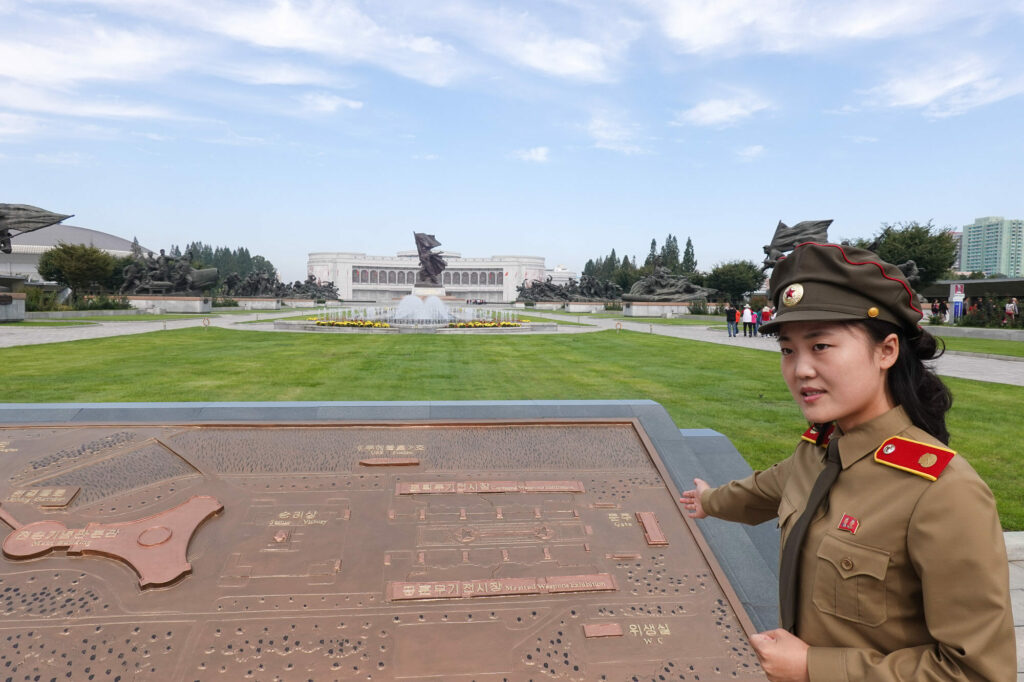
The entry to the museum is a commemorative park that’s 360m in length with open-air arms exhibits and sculptures, headlined by the Monument to Victorious War. The famous USS Pueblo, the ‘American Spy Ship’ captured by North Korea in 1968 is docked here on the Pothong River and is part of tours to the museum.
The Victorious Fatherland Liberation War Museum is as much about documenting the history of the war itself as it’s to showcase the anti-imperialist revolutionary ideas of North Korea’s leaders, President Kim Il Sung and Chairman Kim Jong Il.
History
The museum was first opened in Pyongyang’s Central District during August 1953, the month after the Korean War armistice was signed, and was coined the ‘Fatherland Liberation War Museum’. In April 1974, the museum was relocated to the Sosong District and expanded on the banks of the Pothong River, where it was renamed the Victorious Fatherland Liberation War Museum.
In 1993, the Monument to Victorious War, along with ten flanking group sculptures, was erected on the opposite side of the Pothong River nearby the Victorious Fatherland Liberation War Museum to commemorate the 40th anniversary of Victory Day (the day the Korean Armistice Agreement was signed).
In 2012, major renovations began to move and expand the museum to what was then the forested backdrop of the Monument to Victorious War. This became the main building of the Victorious Fatherland Liberation War Museum, and the old building was closed.
The newly renovated Victorious Fatherland Liberation War Museum was opened on July 27, 2013, which marked the 60th anniversary of Victory Day.
Outside the Museum
The grounds of the Victorious Fatherland Liberation War Museum are vast and beautifully kept with manicured gardens surrounding serene fountains. A procession of patriotic sculptures constructed by Pyongyang’s Mansudae Art Studio leads visitors to the imposing Monument to Victorious War at the entrance of the main building. Inscribed in gold on the base of this monument are the words ‘Respect to the Great Years’ in Marshal Kim Jong Un’s handwriting, and the dates ‘1950-1953’ referring to the dates of the Korean War.
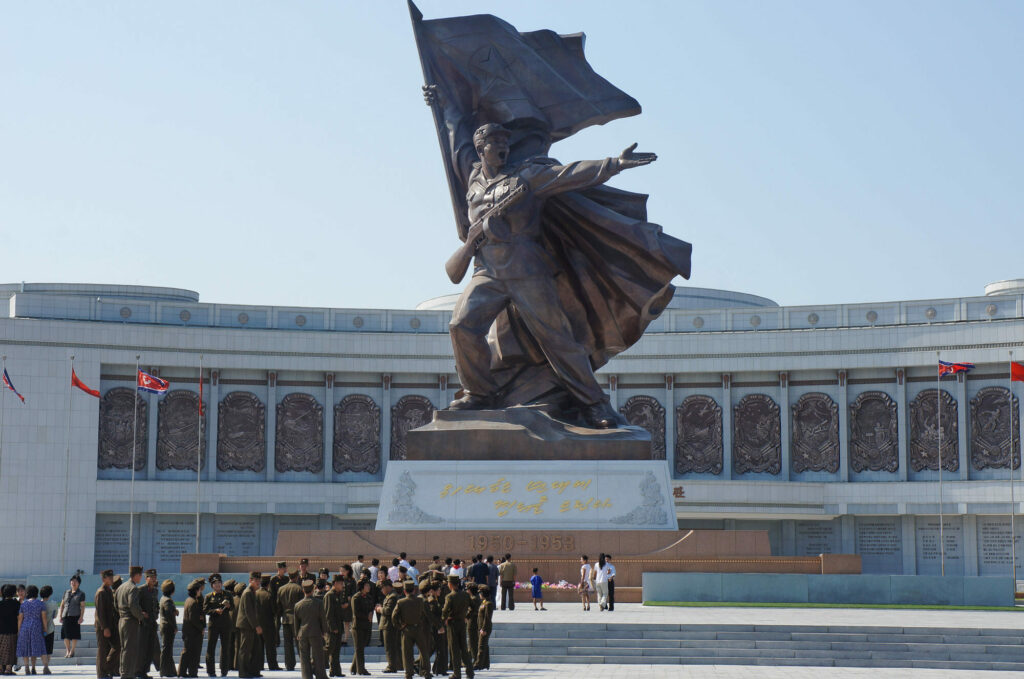
Two massive mosaics feature on the outer walls of the museum, entitled ‘Great Victory in the anti-Japanese Armed Struggle’ and ‘Great Victory in the Fatherland Liberation War’.
Trenches on each side of the park lead down to open-air remnants exhibitions from the Korean War. On the left side is the Merited Weapons Exhibition which is a display of North Korean vehicles and weapons, and on the right side by the river is the Captured Weapons Exhibition showcasing the United States arms and equipment such as tanks, helicopters, and artillery which were captured by the Korean People’s Army. The centerpiece is the ‘American Spy Ship’ USS Pueblo docked here.
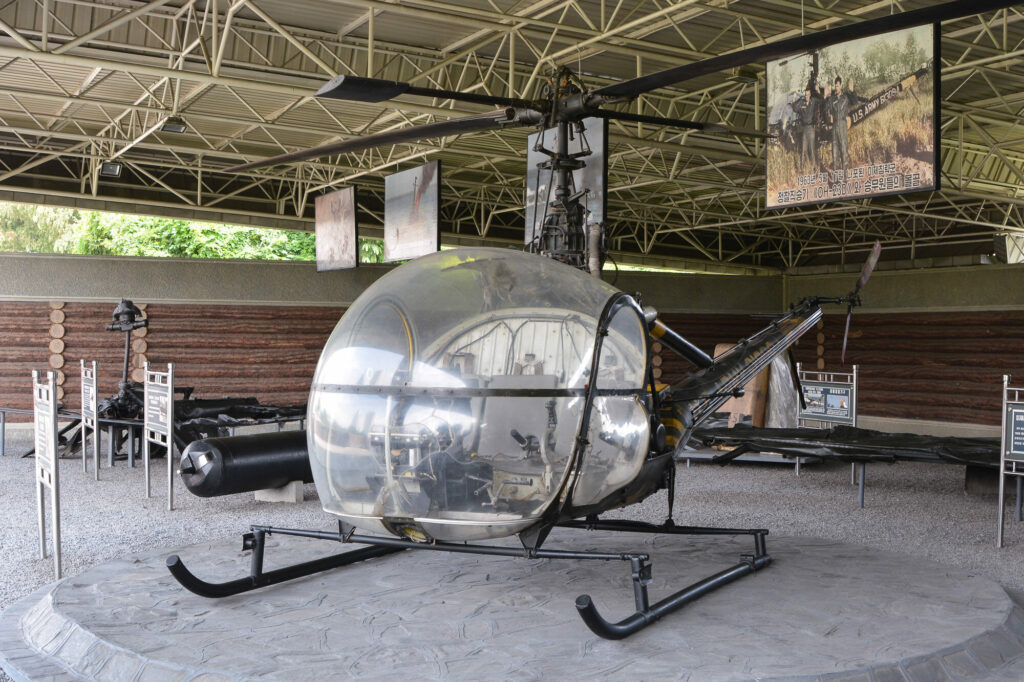
USS Pueblo
The USS Pueblo is a United States Navy vessel that was captured off North Korea’s east coast by the Korean People’s Army Navy on January 23, 1968. The repurposed research vessel had illegally crossed into North Korea’s territorial borders to conduct espionage activities.
During the incident, 1 crewmember was killed and 82 were captured and taken as prisoner, causing an international standoff with negotiations for their release taking place at the Joint Security Area at the DMZ. Following a written admission of espionage activities and an apology from the United States, North Korea released the crew members on December 23, 1968, across the DMZ into South Korea.
North Korea did not return the USS Pueblo, and to this day it remains the only commissioned vessel of the US Navy held captive.
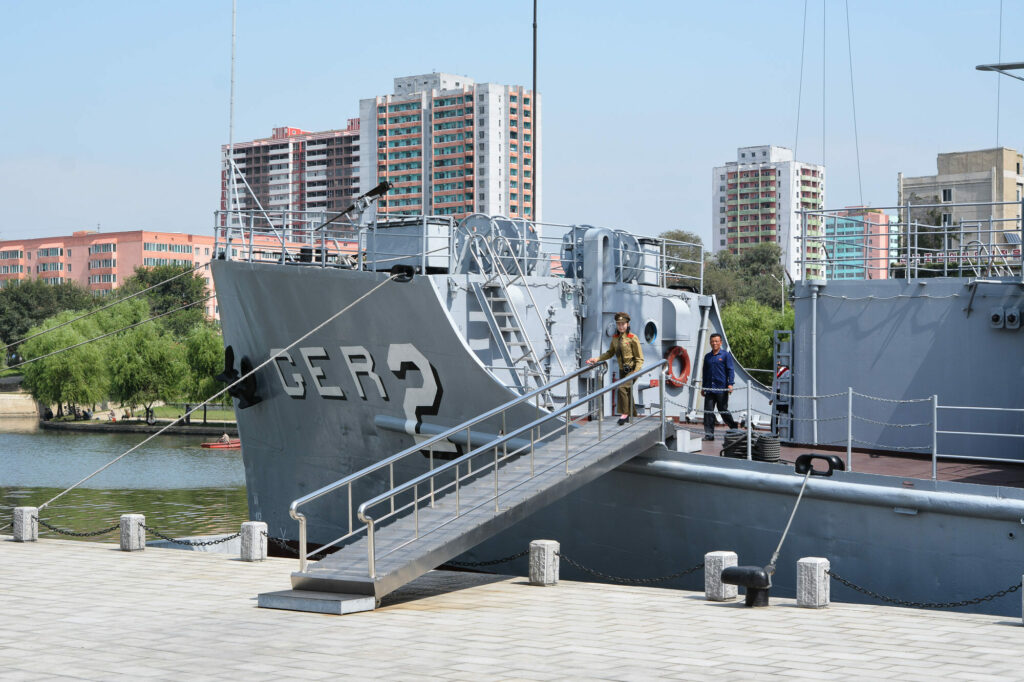
Initially docked in the east coast port city of Wonsan, the USS Pueblo was eventually relocated in 1999 to Pyongyang and was anchored on the Taedong River and became a museum. As part of the 2013 renovations of the Victorious Fatherland Liberation War Museum, it was moved to the Pothong River beside it.
Inside the USS Pueblo, you can still see the bullet holes from the original capture operation, the technology used for spying and framed apology letters from the sailors asking to be sent home.
Inside the Museum
The Victorious Fatherland Liberation War Museum features over 80 exhibit rooms across 30 halls which are broken up by stages of each conflict. The museum catalogs 344 revolutionary relics and over 120,000 historic articles from the war.
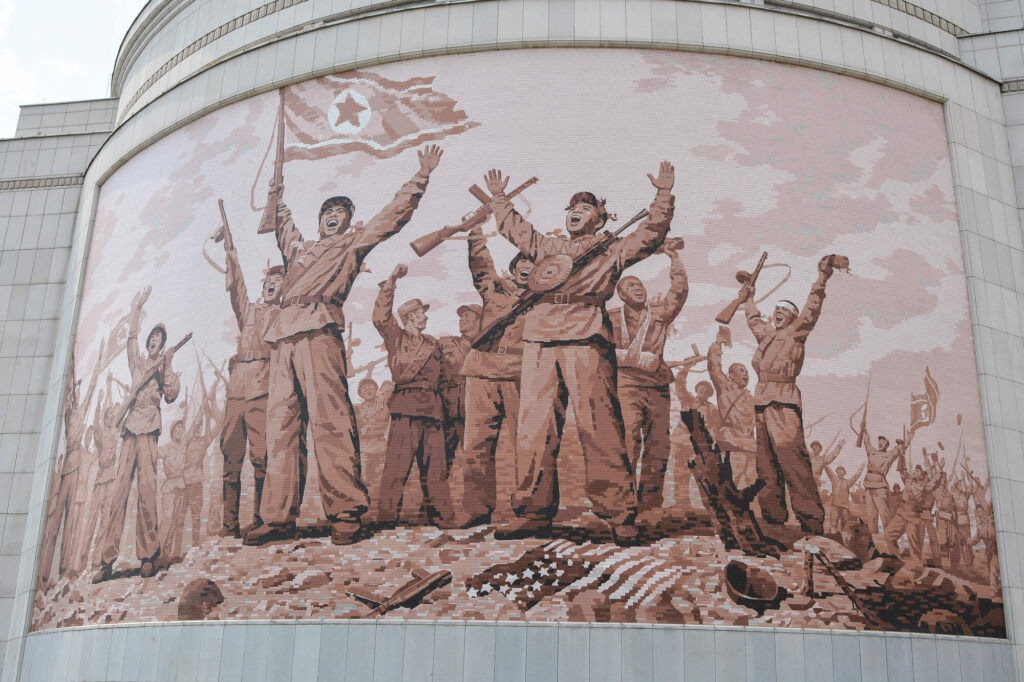
Presentation inside the museum is world-class, with extreme attention to detail and atmospheric design applied to each exhibit through unique uses of lighting, sound, and video. It’s much more than cabinet displays of war remnants and historical photographs, with no expense spared in producing walkthrough bunker reconstructions, immersive scenes of wartime living conditions, interactive tabletop maps, and large-scale dioramas of notable battle sites.
Lobby: The central hall itself is nothing short of spectacular, palatial in scale with pillars and decorations embellished in golden relief. Shined marble floors lead to a grand staircase headed by a wax statue of Generalissimo Kim Il Sung amidst victory celebrations, and a crystal chandelier above in the shape of a star.
Ground Floor: The ground floor includes halls exhibiting the anti-Japanese armed struggle recounting Kim Il Sung’s commanding of a guerilla army to liberate Korea from the Japanese during the ’30s and ’40s. There’s a hall exploring the history and formation of the Korean People’s Army, and a hall of relics outlining the lead up to the outbreak of the Korean War, specifically the evidence of provocation from the United States.
First Floor: The first floor includes halls illustrating President Kim Il Sung’s military leadership and tactics during the Korean War, such as his mapped plans, photographs of notable events, and preserved personal items such as binoculars, typewriters, and letters. Elaborate dioramas of major battles of the Korean War can be found on this floor, such as the ‘Battle of Liberating Seoul’ and ‘Battle on Wolmi Island’. There’s a confronting ‘US Defeat’ room with lifelike wax figures, and halls demonstrating the atrocities committed by the United States during the war. There’s also showing the contributions of the Chinese People’s Volunteer Army and supporting nations such as the USSR.
Second Floor: The second floor Includes halls covering the political history and activities of the Workers’ Party of Korea during the Korean War, and halls depicting the struggles of the Korean people during wartime.
Underground: The underground floor is educational, with a library for war publications, e-learning rooms, projector rooms for screening war films, and lecture rooms for meetings with veterans. There is also a room documenting the history of the museum itself.
Battle of Liberating Taejon Panorama Hall: A hand-painted 360-degree large-scale panorama hall devoted to the ‘Battle of Liberating Taejon’ fought over July 14 – 21, 1950, early in the Korean War. The exhibit reanimates the battle with sound and light effects and is watched from a rotating platform. A major highlight of the museum!
Visiting on Our Tours
The Victorious Fatherland Liberation War Museum is a mainstay on the overwhelming majority of our tours to Pyongyang. It’s an important building block to understanding North Korean history and society. The impact of the two conflicts remains current in the psyche of the North Korean people.
On group tours, visits to the Victorious Fatherland Liberation War Museum take roughly 2 hours which takes in the most impressive halls and key exhibits, including the open-air displays and boarding the USS Pueblo. If you’re a war history buff, you could spend the best part of the day exploring the war museum and we can arrange such visits on private tours. The Victorious Fatherland Liberation War Museum is open every day except Sunday.
All the exhibits are in Korean and you’ll be lead through the museum by a local military guide, who will translate and answer questions.
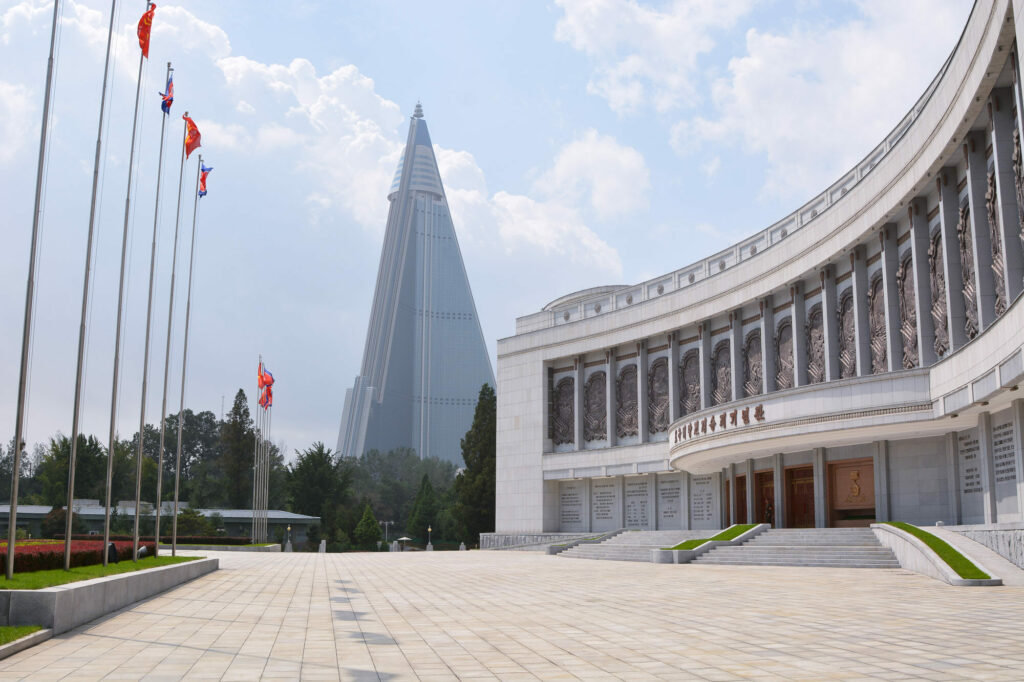
There’s security screening at the gates before heading into the park. Phones and cameras are allowed, but bags should be left on the bus. Photos are welcome in the park and on the USS Pueblo, but photos inside the museum itself are not permitted. The park grounds are also a prime vantage point for photos of the famous Ryugyong Hotel.
As part of the museum visit, there is a 15-minute screening summarising North Korea’s Korean War narrative. The video can be purchased on DVD in the museum. Bring small change for a drink from the coffee shop as you watch!
Circular halls inside the museum are dedicated to the most decorated war heroes, many of which are buried at the Revolutionary Martyrs Cemetery or Fatherland Liberation War Martyrs Cemetery in Pyongyang, which can also be visited on our tours.
To get the most out of your tour to the Victorious Fatherland Liberation War Museum, we recommend brushing up on your Korean War history as it’s fascinating to contrast the foreign narrative with that presented in North Korea.
